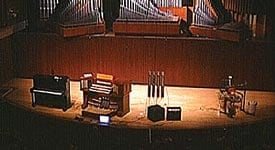RoboRecital Anything but Traditional
 A portion of the "ensemble" assembled for J. Brendan Adamson's "RoboRecital" at the Juilliard School (L to R): a Yamaha Disklavier, Paul Hall's Holtkamp pipe organ console, and a "GuitarBot" and a "ModBot." |
The concert reflected Adamson's fascination with mechanical performance, an interest ignited by Conlon Nancarrow's works. With its impossibly fast and complex runs and rhythms, all of it punched onto piano rolls and run back through the mechanism of the player piano, the Nancarrow catalog makes much of its impact by defying preconceptions of what can and cannot be played on a familiar instrument.
The Disklavier offers a means to achieve similar results without the labor that it took Nancarrow to complete each of his rolls. "Lots of people think of the Disklavier as a way to record and reproduce a live pianist's performance," Adamson says. "But I use it for its ability to exceed physical limitations. Speed, accuracy and precision are limitless with this instrument."
Over the past three years Adamson has written five pieces with and for the Disklavier, several of which – Two Studies for Player Piano (2002), Tides Times Two for Player Piano (2004), and Study for Player Piano (2004) – were featured in the RoboRecital, along with pieces for the organ, GuitarBot, and ModBots, leading to a grand finale with all four instruments playing simultaneously.
While the concept of machines playing themselves is integral to these compositions, Adamson insists that the human element is just as essential, if not quite as apparent. "I did pre-program every aspect of performance, but for most of the audience this was the first time they had heard these works," he explains. "And since I do have complete control over how it sounds, I can conceivably change things from one concert to the next. The subtle interaction of a live performance may not be there in the same way, but the performance itself is fresh to the audiences. I am the interpreter as well as the composer; when you think of it that way, it's not that different from traditional performances."
For more information on Yamaha products, write Yamaha Corporation of America, P.O. Box 6600, Buena Park, CA 90622; telephone (714) 522-9011; or e-mail infostation@yamaha.com.
 |
| © 2010 Yamaha Corporation of America. All rights reserved. |
